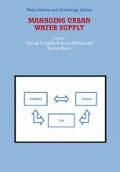Abstract
Urban water supply is a growing issue for many cities and towns. Rapid population growth, drought, ground water contamination, surface water pollution, greater use of water using devices as a result of higher incomes and ground water mining have all led to water shortages in urbanized areas. This book examines how urban water supplies can be managed efficiently while satisfying community standards of equity. It includes economic, managerial, and hydrologic analysis of water pricing, selection of water rate structures, wastewater use, when and how to add new sources of water into the current system, and non-price conservation measures.
Access this chapter
Tax calculation will be finalised at checkout
Purchases are for personal use only
Preview
Unable to display preview. Download preview PDF.
References
Agthe, D.E., “The Potential Costs and Benefits of Inground Storage of Imported Water,” Water Resources Bulletin, 22(1) February: 129–131.
Agthe, D.E., and R.B. Billings, 1997. “Water-Price Effect on Residential and Apartment Low Flow Fixtures,” Journal of Water Resources Planning and Management, 122(l):20–23.
Baker, V., 1999. “Water Science and Policy in the Southwest,” The Faculty Community Lecture Series, The University of Arizona, 4/28.
Billings, R.B., and D.E. Agthe, 1980. “Price Elasticities for Water: A Case of Increasing Block Rates,” Land Economics, 56(1):73–84.
Billings, R.B., and M. Day, 1989. “Demand Management Factors in Residential Water Use: The Southern Arizona Experience,” Journal of the American Water Works Association, 81(3):58–64.
Boulding, K., 1964. “The Economist and the Engineer,” in S.C Smith and E.N. Castle, Eds. Economics and Public Policy in Water Resource Development, Iowa State University Press, Ames):82–92.
Coe, J.L., 1980. “Groundwater Storage for California Project,” Journal the Irrigation and Drainage Division (ASCE):305–315.
Colberg, M. R., 1955. “Utility Profits: a Substitute for Property Taxes,” National Tax Journal, 8, 382–387.
Foster, H., and B. Beattie, 1979. “Urban Residential Demand for Water in the United States,” Land Economics, 55(1): 43–58.
Friedman, M., 1967. Price Theory, Aldine: The University of Chicago Press: 25.
Gleason, E., 1976. “Water Projects Go Underground,” Ecology Law Quarterly, 5:625–668.
Gottlieb, M, 1963. “Urban Domestic Demand for Water: A Kansas Study,” Land Economics, 39(2):204–210.
Haerlin, B., and D. Parr, 1999. “How to Restore Public Trust in Science,” Nature, 400, August 5th: 499.
Howe, C.W., and F.P. Iinaweaver, 1967. “The Impact of Price on Residential Water Demand and Its Relation to System Design and Price Structure,” Water Resources Research, 3 (l):13–32.
Johnson, D., 1988. “Down the Drain,” The Los Angeles Times, Feb. 2, Sect 5:1.
Kelso, M.M., Martin, W.E., and Mack, L.E., 1973. Water Supplies and Growth in an Arid Environment, University of Arizona Press, Tucson.
Leftwich, R.H., 1966. The Price System and Resource Allocation: Third Edition, Holt, Rienhart, and Winston, Inc.:16.
Martin, WE., and J.F. Thomas, 1986. “Policy Relevance in Studies of Urban Residential Water Demand,” Water Resources Research, 22 (13):1735–1741.
Morgan, W.D., 1973. “Residential Water Demand: The Case from Microdata,” Water Resources Research, 9 (4):1065–1067.
Morgenstern, R.D., Ed., 1997. Economic Analysis at EPA, Resources for the Future: Washington, D.C.
Pollock, R.A., 1998. “Imagined Risks and Cost-Benefit Analysis,” The American Economic Review, 88 (2):376–380.
Portney, P.R., 1992. “Trouble in Happyville,” Journal of Policy Analysis and Management, 11(1):131–132.
Stigler, G., 1966. The Theory of Price, The MacMillan Company, New York.
Wong, S.T., 1972. “A Model on Municipal Water Demand: A Case Study of Northeastern Illinois,” Land Economics, 48 (l):34–44.
Author information
Authors and Affiliations
Editor information
Editors and Affiliations
Rights and permissions
Copyright information
© 2003 Springer Science+Business Media Dordrecht
About this chapter
Cite this chapter
Agthe, D.E., Billings, R.B., Buras, N. (2003). Introduction. In: Agthe, D.E., Billings, R.B., Buras, N. (eds) Managing Urban Water Supply. Water Science and Technology Library, vol 46. Springer, Dordrecht. https://doi.org/10.1007/978-94-017-0237-9_1
Download citation
DOI: https://doi.org/10.1007/978-94-017-0237-9_1
Publisher Name: Springer, Dordrecht
Print ISBN: 978-90-481-6470-7
Online ISBN: 978-94-017-0237-9
eBook Packages: Springer Book Archive

